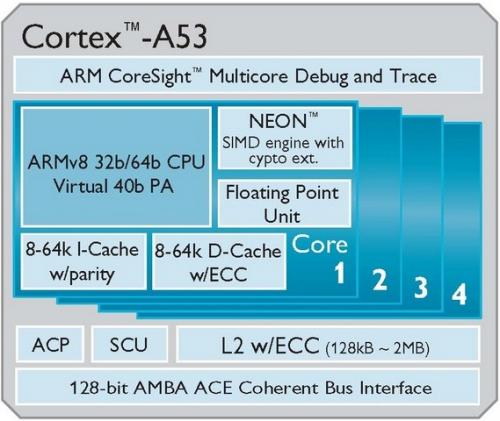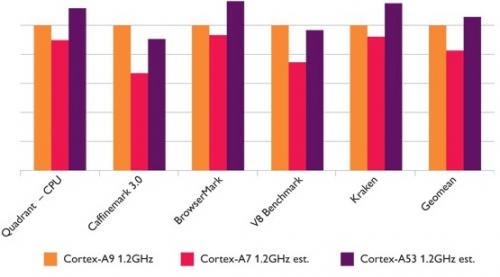ARM Cortex-A53处理器详细介绍
Cortex-A53处理器简介
The Cortex-A53 processor is ARM's most efficient application processor ever, delivering today's mainstream smartphone experience in a quarter of the power in the respective process nodes.
The Cortex-A53 extremely power efficient ARMv8 processor is capable of supporting 32-bit ARMv7 code and 64-bit code in the AArch64 execution state. It delivers more performance at higher power efficiency than the Cortex-A7 processor, and is capable of being deployed as a standalone main applications processor or as a companion to Cortex-A57 in a big.LITTLE processor.
The Cortex-A53 processor can be implemented individually or paired with the Cortex-A57 processor in a big.LITTLE configuration for optimum performance, scalability and energy efficiency.

图1.Cortex-A53处理器图片
为什么选择Cortex-A53处理器
Using ARM's big.LITTLE technology the Cortex-A53 processor will efficiently run your connected life. This connected life will not just be the social media, news and email updates that you receive today, but will also enable devices to be contextually aware and connect to the Internet of things. Contextual awareness is already happening in smartphones today, but with the Cortex-53 processor's ultra efficiency will allow your smartphone to use its sensor information, calendar, contact information and location-based services to provide relevant information.
The Cortex-A53 processor
Can deliver the compute power of today’s high-end smartphone, in lowest power and area footprint, enabling all-day battery life for typical device uses Eficiently run legacy ARM 32-bit applications Features cache coherent interoperability with ARM Mali family graphics processing units (GPUs) for GPU compute applications Offers optional reliability and scalability features for high-performance enterprise applications Connects seamlessly to ARMs interconnect with up to 16 cores configurations with more in the futureCortex-A53处理器性能
The Cortex-A53 processor delivers significantly more performance than its predecessors at a higher level of power efficiency, effectively taking the performance of the LITTLE core above that of the Cortex-A9 processor, which defines today's high-end mobile platforms.
The performance graph below shows measured results on Cortex-A9 and early Cortex-A7 test platforms. The results are projected to deliver performance in a quad-core configuration on a "rate" benchmark that tests integer and some floating-point performance with a mix of large and medium data sets. These stress the memory system of each CPU and the L2 cache. The "rate" portion of the benchmark duplicates the same code on the 2nd, 3rd, and 4th CPUs in each system, and measures the delivered aggregate performance. Rate benchmarks like this evaluate the ability of the multi-processing system to handle memory traffic and coherence requirements in a multiprocessing context.

图2.
The Cortex-A53 is able to deliver more performance than Cortex-A9 systems of comparable speed on this benchmark. The performance graph below shows measure results running various Android benchmarks on dual-core Cortex-A9, dual-core Cortex-A7, and projected results on dual-core Cortex-A53 platforms based on measured uplift vs. Cortex-A7 on similar types of code. The results show that Cortex-A53 delivers comparable but slightly lower performance relative to Cortex-A9 running at the same frequency, while Cortex-A53 delivers higher performance than Cortex-A9 at the same frequency.

表1.
* Estimated
** Provisonal

图3.
Cortex-A53处理器产品规格
Cortex-A53 ARMv8 ARM 相关文章:
- A57处理器即将量产 同等功耗下性能提升三倍(03-09)
- ARM Cortex-A50 系列应用处理器重点分析(07-11)
- ARM展望2017:根本就没把x86放在眼里(11-24)
- 麒麟960板卡曝光,这颜值值得点赞?(05-29)
- ARM Cortex-A50系列处理器全面分析(07-11)
- ARM与联华电子达成最新的28HPC POP工艺合作(01-05)
